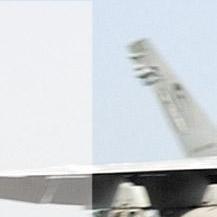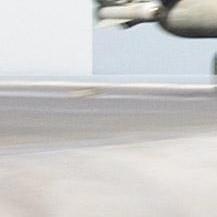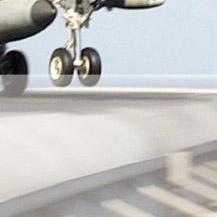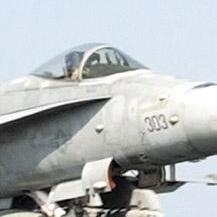
6 minute read
Quick Decisions, Quick Mistakes
By AM2(AW) James Domholdt, VFA-83

Advertisement



Quick decisions are part of life on the flight deck of an aircraft carrier, but they can cause loss of equipment, aircraft, or even lives. As aircraft maintainers, we need to fully comprehend what is at stake when we make split-second decisions. We are trained, specific policies and procedures are put in place, and maintenance instruction manuals (MIMs) were written. Yet, human error remains the greatest cause of mishaps within the fleet.
After working on high-performance aircraft like the FA-18C Hornet, I know the key to success is communication. Maintenance control is the heart and soul of naval aviation, and accurate communication is a must; whether you’re talking about something as simple as a loose fastener, or as major as a missing cotter pin on a flight-control surface.
Recently, I was embarked onboard the USS John F. Kennedy (CV-67) during a carrier landing practice detachment. As a final checker, I was responsible for ensuring aircraft were safe to launch. On one particular event, a functional check flight (FCF) was required because a trailing-edge flap (TEF) servo had been replaced. While the pilot was doing his normal checks, I discovered that a cotter key was missing from an attachment bolt that connected the scissor-arm assembly to the TEF assembly. It was on the same side as the TEF servo that had been changed the night before. The nut was tightened down on the bolt, the cotter pin hole was lined up, but no cotter pin was installed. I know that it is easier to overlook things while working at night; however, these discrepancies obviously must be caught and corrected, long before a pilot walks to the aircraft.
When anyone removes and replaces flight-critical equipment that will require an FCF, a minimum of three sets of eyes must look over the job. First we have the maintainer who removes and replaces the defective piece of equipment. Next is the collateral duty inspector (CDI), who is responsible for inspecting the maintainer’s work and making sure the job is complete. When the CDI determines that the maintenance action was completed in accordance with the MIMs, the CDI tells maintenance control that the repair is ready for a final inspection. This inspection is done by a quality assur



ance representative (QAR). From my experience, I knew that the bolt in question didn’t have to be removed to replace the TEF servo. I assumed that the cotter pin mistakenly had been removed and not replaced. Due to a lack of communication between the maintainer, the CDI, and the QAR, the removal of the pin hadn’t been mentioned, so no inspector looked over the area.
After discovering that the pin was missing, I looked for the QAR who was on the flight deck acting as the safety observer. I told him the pin had been missed in the launch sequence, while preparing for this FCF. I said, “We could safety wire the cotter-pin hole and that should secure the nut for the flight.” The cotter pin could then be replaced when the aircraft returned from the flight.
The QAR agreed, partly because he had done the walkaround on the aircraft earlier that morning, and he had overlooked it as well. That’s when we “knowledgeable” maintainers decided to cover up the mistake and not to inform anyone. I had nothing to lose except my integrity, and at that very moment, I did exactly that. I
let my friendship get in the way of doing what was right. I was more worried about saving my old work center and peers the hassle of dealing with the problem, than I was about the outcome. I knew it was wrong, yet I decided to jury-rig a fix, without documenting it. It did not seem like that big a deal, but it was not authorized, and I did not tell the flight-deck coordinator (FDC) about the problem. If I had, the launch would have been suspended until the problem was corrected.
I was called away from this aircraft to troubleshoot another aircraft on the bow of the ship. Before I left, my conscience started to weigh on me. I told a first class petty officer of the plan to safety wire the nut and to fix it when the aircraft returned. We both agreed that it should be kept quiet so as not to cause all the hassles associated with CDI and QAR adverse monitors. The first class and the QAR both agreed, and after I departed, they installed the safety wire without telling anyone. As the jet taxied to the catapult, I asked whether the nut was safety wired. I was told it was. It seemed, at the time, that we had gotten away with an








improper maintenance action.
The aircraft returned from the FCF with no discrepancies. After debriefing the pilot, the QAR and I removed the safety wire and replaced it with a cotter pin. As the day progressed, the QAR who helped safety wire the bolt told his LPO about the events of the day. That’s when the red flag went up.
The LPO was a QAR with great integrity. He told maintenance control that there was a serious training issue at hand and that it needed immediate attention. Maintenance control had been unaware of the situation. Once they were informed, all individuals involved were called in to hear the details of the incident.
I was on the flight deck when the call came up to the FDC. I was told to go down immediately to maintenance control. My heart sank. As I made my way back through the hatches and knee knockers to maintenance control, I kept wondering; “How did they find out? What are they going to say?” I knew that I should have told someone about the missing cotter pin instead of trying to cover it up.
The maintenance chiefs asked for details: What happened with the safety wire? Was it still in the flap attachment bolt? Was it replaced? Did anyone see that it was replaced? Were we flying an unsafe aircraft? I told them that as soon as the jet landed, a new cotter pin had been installed, and QA witnessed the installation.
The jet was safe, but that was not the point. I had made a very immature and very dangerous decision. Instead of living up to Navy Core Values, I acted without considering all of the factors involved in the launch of the aircraft. I had failed to consider the aircrew, the maintainers, others working on the flight deck, and the maintenance chief that signed “Safe for Flight,” all in an effort to save someone from the repercussions of poor maintenance practices.
I learned a valuable lesson that day: Covering up things is not the way to go. The others involved and I had our qualifications revoked. We have conducted formal training in all maintenance work centers in hopes that this situation will never happen again. I lost a lot of respect and integrity with one hasty decision. It will take a lot of hard work and a very long time to regain it.










